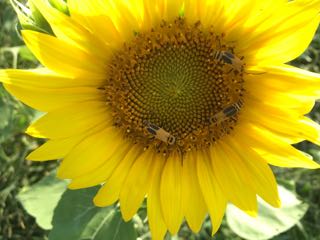 Recently, we shared the story of the sunflowers and oats that grew from the seeds that the roosters missed. It’s pretty amazing that they just grew where they fell, without tending, among the pasture plants.
Recently, we shared the story of the sunflowers and oats that grew from the seeds that the roosters missed. It’s pretty amazing that they just grew where they fell, without tending, among the pasture plants.
The sunflowers are so cheery – you can’t really look at their big yellow faces without smiling. We check them every day, and were shocked to discover that some had been badly chewed up by bugs. What bugs would do this? We had seen Japanese beetles on the blackberry bushes, but none on the sunflowers. What was on them – in large numbers – was a different type of beetle. This one was longer in the body and had mostly orange and black markings.
We don’t use chemical insecticides on our pasture, so we mixed up some castile soap in water and put in a few drops of cedarwood oil. We sprayed down the beetles with it, liberally, and shook them off the flowers. The chickens, loitering nearby, weren’t interested in the beetles at all. The beetles (many of them mating) seemed a bit annoyed, but rapidly returned to the flowers.
What were these pesky beetles that were eating our cheerful sunflowers and laughing at the soapy water spray? Turns out that they’re not the sunflower-eating culprits, after all. These were Goldenrod Leatherwings, a type of soldier beetle. They’re beneficial insects, pollinators and eaters of pests like aphids (probably the real sunflower-eaters). Gardeners want these beetles in their gardens to help keep the pests at bay. If you see them in your garden, welcome them.
Lesson learned: know your beetle before you try to chase it away.
